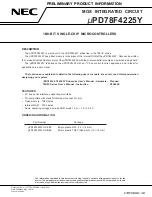
Mounting and wiring
CX8050, CX8051 - Embedded-PCs for
CANopen and CAN
26
Version: 1.4
5.2.3
CANopen Cabling
CAN topology
CAN is a 2-wire bus system, to which all participating devices are connected in parallel (i.e. using short drop
lines). The bus must be terminated at each end with a 120 (or 121) Ohm terminating resistor to prevent
reflections. This is also necessary even if the cable lengths are very short!
Since the CAN signals are represented on the bus as the difference between the two levels, the CAN leads
are not very sensitive to incoming interference (EMI): Both leads are affected, so the interference has very
little effect on the difference.
Bus length
The maximum length of a CAN bus is primarily limited by the signal transit time. The multi-master bus access
procedure (arbitration) requires signals to reach all the nodes at effectively the same time (before the
sampling within a bit period). Since the signal transit times in the CAN connecting equipment (transceivers,
opto-couplers, CAN controllers) are almost constant, the line length must be chosen in accordance with the
baud rate:
Baud Rate
Bus length
1 Mbit/s
< 20 m*
500 kbit/s
< 100 m
250 kbit/s
< 250 m
125 kbit/s
< 500 m
50 kbit/s
< 1000 m
20 kbit/s
< 2500 m
10 kbit/s
< 5000 m
*) A figure of 40 m at 1 Mbit/s is often found in the CAN literature. This does not, however, apply to networks
with optically isolated CAN controllers. The worst case calculation for opto-couplers yields a figure 5 m at
1 Mbit/s - in practice, however, 20 m can be reached without difficulty.
It may be necessary to use repeaters for bus lengths greater than 1000 m.
Summary of Contents for CX8050
Page 2: ......
















































